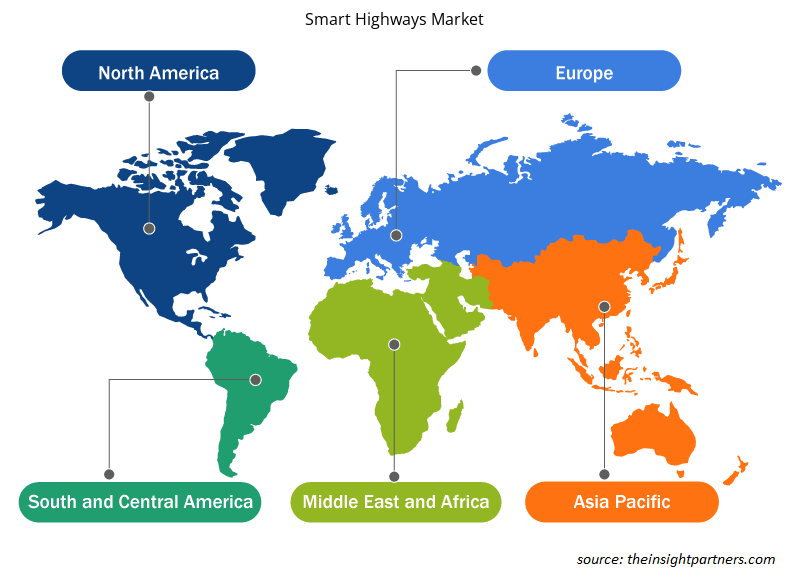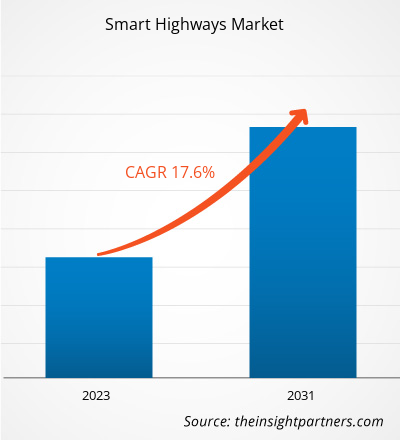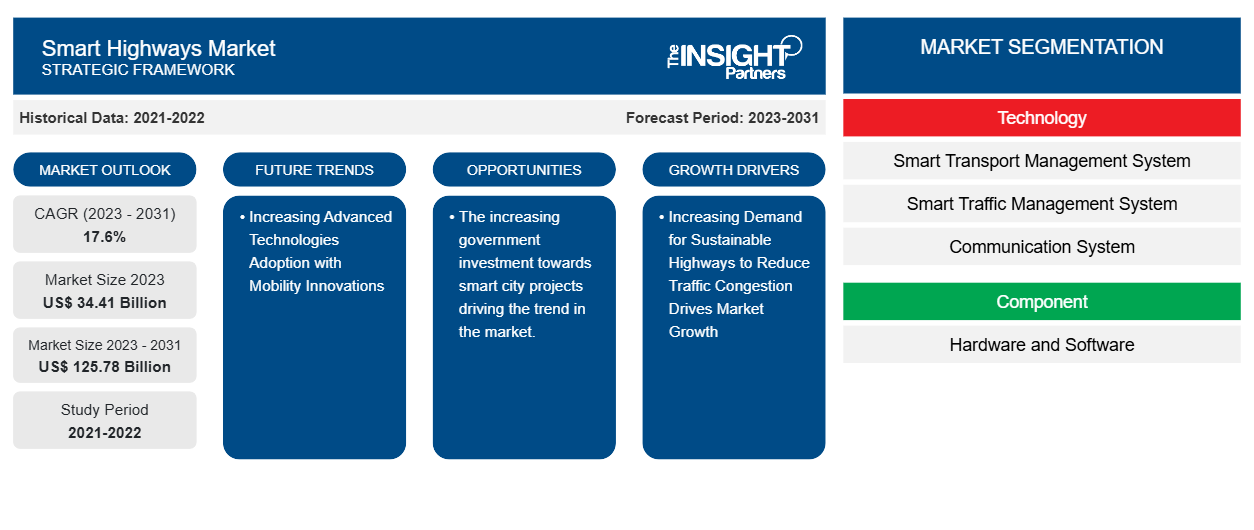Se proyecta que el tamaño del mercado de autopistas inteligentes alcance los 125.780 millones de dólares en 2031, frente a los 34.410 millones de dólares en 2023. Se espera que el mercado registre una CAGR del 17,6 % durante el período 2023-2031. Las crecientes iniciativas gubernamentales para el desarrollo de ciudades inteligentes impulsan el crecimiento del mercado. La creciente adopción de tecnologías avanzadas para el establecimiento de ciudades inteligentes en todo el mundo es una tendencia impulsora en el mercado.
Análisis del mercado de autopistas inteligentes
El creciente desarrollo de autopistas inteligentes con la integración de tecnologías avanzadas, como inteligencia artificial, Internet de las cosas y dispositivos conectados, en las vías de transporte impulsa el crecimiento del mercado de autopistas inteligentes. Hay varios organismos gubernamentales que planean modificar sus rutas, especialmente las autopistas, para respaldar los sistemas de transporte inteligentes y la infraestructura vial en todo el mundo. Por ejemplo, en Europa, los sistemas de transporte inteligentes cooperativos se construyeron para carreteras inteligentes que permiten a los usuarios de las carreteras y a los administradores de tráfico coordinar y compartir información útil sobre las actividades viales.
Panorama del mercado de autopistas inteligentes
La creciente adopción y desarrollo de proyectos de “ ciudades inteligentes ” en áreas urbanas con la integración de una amplia red de sensores para promover una mejor conectividad impulsa el crecimiento del mercado. Las ciudades inteligentes de todo el mundo están experimentando cambios significativos para mejorar la vida de los ciudadanos, hacerla más eficiente y ecológica. Se prevé que innovaciones como la construcción de ciudades inteligentes impulsen significativamente el mercado de las autopistas inteligentes en los próximos años.
Con proyectos tanto del sector público como del privado, la ciudad de Nueva York está experimentando actualmente una transformación digital con tecnología de vanguardia que ofrecen el Internet de las cosas y los dispositivos conectados.
Personalice este informe según sus necesidades
Obtendrá personalización en cualquier informe, sin cargo, incluidas partes de este informe o análisis a nivel de país, paquete de datos de Excel, así como también grandes ofertas y descuentos para empresas emergentes y universidades.
-
Obtenga las principales tendencias clave del mercado de este informe.Esta muestra GRATUITA incluirá análisis de datos, desde tendencias del mercado hasta estimaciones y pronósticos.
Impulsores y oportunidades del mercado de autopistas inteligentes
La creciente demanda de carreteras sostenibles para reducir la congestión del tráfico impulsa el crecimiento del mercado
Una carretera sostenible permite el desarrollo social y el crecimiento económico y reduce los impactos negativos sobre el medio ambiente. Según la Administración Federal de Carreteras (FHWA), las carreteras sostenibles son una parte integral del desarrollo sostenible que debe evaluarse y considerarse para su implementación a lo largo de su ciclo de vida, desde el diseño hasta la construcción, las operaciones y el mantenimiento. Además de abordar las necesidades ambientales y de recursos naturales, una carretera sostenible satisface la demanda de accesibilidad a los servicios de transporte y rutas seguras y cómodas para caminar, andar en bicicleta y transitar. Las autoridades de carreteras de los EE. UU. están abordando la sostenibilidad a través de una amplia gama de iniciativas, como los sistemas de transporte inteligente (ITS), el reciclaje, la planificación, los vínculos con el medio ambiente y los requisitos de la Ley Nacional de Política Ambiental (NEPA).
El aumento del gasto público en construcción e infraestructura vial ofrecerá más oportunidades para el mercado de autopistas inteligentes de América del Norte. El gasto público en construcción en proyectos de carreteras y calles en Estados Unidos alcanzó los 95.500 millones de dólares en 2021, según el Departamento de Transporte de Estados Unidos. Además, según el Departamento de Transporte de Estados Unidos, se han invertido alrededor de 350 millones de dólares en fondos públicos y privados para el desarrollo de ciudades inteligentes.
Aumentar la adopción de tecnologías avanzadas con innovaciones en movilidad
Varias tecnologías, como el Wi-Fi en malla ad-hoc y el sistema de comunicación celular entre vehículos (C-V2X), mantienen a los conductores informados de los cambios en los semáforos y se comunican con otros vehículos para evitar colisiones. Se prevé que las innovaciones en tecnologías digitales proporcionen oportunidades de crecimiento lucrativas para los actores del mercado de las carreteras inteligentes durante el período de pronóstico. Los gobiernos de todo el mundo están invirtiendo significativamente en tecnologías de vehículos conectados para impulsar el crecimiento del mercado de las carreteras inteligentes. Por ejemplo, el Departamento de Transporte de Colorado planea equipar 2.500 vehículos gubernamentales con tecnologías C-V2X y Comunicaciones Dedicadas de Corto Alcance (DSRC) en 10 años. En China, el gobierno ha adoptado ampliamente C-V2X como un facilitador clave de los vehículos conectados, ya que proporciona una amplia cobertura.
Análisis de segmentación del informe de mercado de autopistas inteligentes
Los segmentos clave que contribuyeron a la derivación del análisis del mercado de carreteras inteligentes son la tecnología de disco, los componentes y la geografía.
- Según la tecnología, el mercado se divide en sistemas de gestión de transporte inteligente, sistemas de gestión de tráfico inteligente , sistemas de comunicación, sistemas de monitoreo y otros. Entre estos, los sistemas de gestión de transporte inteligente tuvieron la mayor participación en 2023. Esto se debe al aumento de la inversión en ciudades inteligentes con iniciativas gubernamentales.
- Según el componente, el mercado se divide en hardware y software. Entre estos, el segmento de hardware tendrá una mayor participación en 2023. Esto se debe al aumento de las inversiones en ciudades inteligentes.
Análisis de la cuota de mercado de las autopistas inteligentes por geografía
El alcance geográfico del informe del mercado de carreteras inteligentes se divide principalmente en cinco regiones: América del Norte, Asia Pacífico, Europa, Medio Oriente y África, y América del Sur.
Se espera que América del Norte tenga la mayor participación en 2023. Esto se debe principalmente al aumento de las inversiones en autopistas para pagar puentes, autopistas de peaje y túneles. Hay más de 300 instalaciones en todo Estados Unidos que transforman el panorama del transporte por carretera y las autopistas de la región. Según las herramientas de visualización de datos de Toll Miner, hay más de 114 operadores que gestionan más de 321 instalaciones de peaje en Estados Unidos. Esto utiliza ETC, que cubre la friolera de 6.235 millas de carretera en línea central. Por lo tanto, la adopción a gran escala de sistemas de peaje automatizados, que eliminan los pagos en efectivo (y las plazas de peaje) de las instalaciones, fomenta la implementación exitosa de otros componentes y tecnologías de autopistas inteligentes en América del Norte.
Perspectivas regionales del mercado de autopistas inteligentes
Los analistas de Insight Partners explicaron en detalle las tendencias y los factores regionales que influyen en el mercado de autopistas inteligentes durante el período de pronóstico. Esta sección también analiza los segmentos y la geografía del mercado de autopistas inteligentes en América del Norte, Europa, Asia Pacífico, Oriente Medio y África, y América del Sur y Central.

- Obtenga datos regionales específicos para el mercado de autopistas inteligentes
Alcance del informe de mercado de autopistas inteligentes
| Atributo del informe | Detalles |
|---|---|
| Tamaño del mercado en 2023 | US$ 34,41 mil millones |
| Tamaño del mercado en 2031 | US$ 125,78 mil millones |
| CAGR global (2023 - 2031) | 17,6% |
| Datos históricos | 2021-2022 |
| Período de pronóstico | 2023-2031 |
| Segmentos cubiertos |
Por tecnología
|
| Regiones y países cubiertos |
América del norte
|
| Líderes del mercado y perfiles de empresas clave |
|
Densidad de actores del mercado de autopistas inteligentes: comprensión de su impacto en la dinámica empresarial
El mercado de autopistas inteligentes está creciendo rápidamente, impulsado por la creciente demanda de los usuarios finales debido a factores como la evolución de las preferencias de los consumidores, los avances tecnológicos y una mayor conciencia de los beneficios del producto. A medida que aumenta la demanda, las empresas amplían sus ofertas, innovan para satisfacer las necesidades de los consumidores y aprovechan las tendencias emergentes, lo que impulsa aún más el crecimiento del mercado.
La densidad de actores del mercado se refiere a la distribución de las empresas o firmas que operan dentro de un mercado o industria en particular. Indica cuántos competidores (actores del mercado) están presentes en un espacio de mercado determinado en relación con su tamaño o valor total de mercado.
Las principales empresas que operan en el mercado de autopistas inteligentes son:
- Conductor
- Cª
- Tecnologías Huawei Co., Ltd.
- Grupo IBI
- Cisco
- Kapsch TrafficCom AG
Descargo de responsabilidad : Las empresas enumeradas anteriormente no están clasificadas en ningún orden particular.

- Obtenga una descripción general de los principales actores clave del mercado de autopistas inteligentes
Noticias y desarrollos recientes del mercado de autopistas inteligentes
El mercado de las autopistas inteligentes se evalúa mediante la recopilación de datos cualitativos y cuantitativos a partir de investigaciones primarias y secundarias, que incluyen importantes publicaciones corporativas, datos de asociaciones y bases de datos. A continuación, se enumeran algunos de los avances en el mercado de las autopistas inteligentes:
- En el marco del proyecto de ciudad inteligente de la India, se han desarrollado dos carreteras, y la capital se ha abierto al público. Las autopistas inteligentes construidas desde Althara hasta Chenthitta pasando por Vazhuthacaud y Thycaud se completarán a fines de abril de 2024. La carretera Killipalam-Attakulangara se completó en la segunda semana de mayo de 2024. (Fuente: Times of India-Newsletter, marzo de 2024)
- Iteris, Inc., el ecosistema tecnológico de confianza del mundo para la gestión de infraestructuras de movilidad inteligente, anunció hoy que Carson City, Nevada, EE. UU., ha optado por actualizar los sensores de detección de intersecciones de la ciudad a los sensores híbridos Vantage Apex de Iteris. Vantage Apex es el primer sensor de radar de cuatro dimensiones (4D) y video de alta definición (HD) de 1080p de la industria con algoritmos de inteligencia artificial (IA) integrados. Ofrece una precisión de detección, seguimiento y clasificación de vanguardia de vehículos, peatones y ciclistas, así como una visualización de video HD para el monitoreo del centro de gestión del tráfico. (Fuente: Comunicado de prensa, abril de 2024)
Informe sobre el mercado de autopistas inteligentes: cobertura y resultados
El informe “Tamaño y pronóstico del mercado de autopistas inteligentes (2021-2031)” proporciona un análisis detallado del mercado que cubre las siguientes áreas:
- Tamaño del mercado de autopistas inteligentes y pronóstico a nivel mundial, regional y nacional para todos los segmentos clave del mercado cubiertos bajo el alcance
- Tendencias del mercado de autopistas inteligentes, así como dinámicas del mercado, como impulsores, restricciones y oportunidades clave
- Análisis PEST y FODA detallados
- Análisis del mercado de autopistas inteligentes que abarca las tendencias clave del mercado, el marco global y regional, los principales actores, las regulaciones y los desarrollos recientes del mercado
- Análisis del panorama de la industria y de la competencia que abarca la concentración del mercado, el análisis de mapas de calor, los actores destacados y los desarrollos recientes del mercado de autopistas inteligentes
- Perfiles detallados de empresas
- Análisis histórico (2 años), año base, pronóstico (7 años) con CAGR
- Análisis PEST y FODA
- Tamaño del mercado, valor/volumen: global, regional y nacional
- Industria y panorama competitivo
- Conjunto de datos de Excel
Informes recientes
Testimonios
Razón para comprar
- Toma de decisiones informada
- Comprensión de la dinámica del mercado
- Análisis competitivo
- Información sobre clientes
- Pronósticos del mercado
- Mitigación de riesgos
- Planificación estratégica
- Justificación de la inversión
- Identificación de mercados emergentes
- Mejora de las estrategias de marketing
- Impulso de la eficiencia operativa
- Alineación con las tendencias regulatorias























 Obtenga una muestra gratuita para - Mercado de autopistas inteligentes
Obtenga una muestra gratuita para - Mercado de autopistas inteligentes